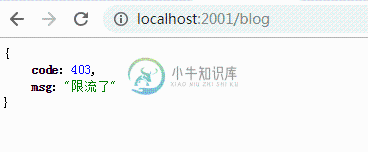阿里Sentinel支持Spring Cloud Gateway的实现
1. 前言
4月25号,Sentinel 1.6.0 正式发布,带来 Spring Cloud Gateway 支持、控制台登录功能、改进的热点限流和注解 fallback 等多项新特性,该出手时就出手,紧跟时代潮流,昨天刚发布,今天我就要给大家分享下如何使用!
2. 介绍(本段来自Sentinel文档)
Sentinel 1.6.0 引入了 Sentinel API Gateway Adapter Common 模块,此模块中包含网关限流的规则和自定义 API 的实体和管理逻辑:
GatewayFlowRule:网关限流规则,针对 API Gateway 的场景定制的限流规则,可以针对不同 route 或自定义的 API 分组进行限流,支持针对请求中的参数、Header、来源 IP 等进行定制化的限流。
ApiDefinition:用户自定义的 API 定义分组,可以看做是一些 URL 匹配的组合。比如我们可以定义一个 API 叫 my_api,请求 path 模式为 /foo/ 和 /baz/ 的都归到 my_api 这个 API 分组下面。限流的时候可以针对这个自定义的 API 分组维度进行限流。
其中网关限流规则 GatewayFlowRule 的字段解释如下:
- resource:资源名称,可以是网关中的 route 名称或者用户自定义的 API 分组名称。
- resourceMode:规则是针对 API Gateway 的 route(RESOURCE_MODE_ROUTE_ID)还是用户在 Sentinel 中定义的 API 分组(RESOURCE_MODE_CUSTOM_API_NAME),默认是 route。
- grade:限流指标维度,同限流规则的 grade 字段
- count:限流阈值
- intervalSec:统计时间窗口,单位是秒,默认是 1 秒
- controlBehavior:流量整形的控制效果,同限流规则的 controlBehavior 字段,目前支持快速失败和匀速排队两种模式,默认是快速失败。
- burst:应对突发请求时额外允许的请求数目。
- maxQueueingTimeoutMs:匀速排队模式下的最长排队时间,单位是毫秒,仅在匀速排队模式下生效。
- paramItem:参数限流配置。若不提供,则代表不针对参数进行限流,该网关规则将会被转换成普通流控规则;否则会转换成热点规则。其中的字段:
- parseStrategy:从请求中提取参数的策略,目前支持提取来源 IP(PARAM_PARSE_STRATEGY_CLIENT_IP)、Host(PARAM_PARSE_STRATEGY_HOST)、任意 Header(PARAM_PARSE_STRATEGY_HEADER)和任意 URL 参数(PARAM_PARSE_STRATEGY_URL_PARAM)四种模式。
- fieldName:若提取策略选择 Header 模式或 URL 参数模式,则需要指定对应的 header 名称或 URL 参数名称。
- pattern 和 matchStrategy:为后续参数匹配特性预留,目前未实现。
用户可以通过 GatewayRuleManager.loadRules(rules) 手动加载网关规则,或通过 GatewayRuleManager.register2Property(property) 注册动态规则源动态推送(推荐方式)。
3. 使用
3.1 快速体验
首先你的有一个Spring Cloud Gateway的项目,如果没有,新建一个,增加Gateway和sentinel-spring-cloud-gateway-adapter的依赖,如下:
<dependency> <groupId>org.springframework.cloud</groupId> <artifactId>spring-cloud-starter-gateway</artifactId> </dependency> <dependency> <groupId>com.alibaba.csp</groupId> <artifactId>sentinel-spring-cloud-gateway-adapter</artifactId> <version>1.6.0</version> </dependency>
新建一个application.yml配置文件,用来配置路由:
server:
port: 2001
spring:
application:
name: spring-cloud-gateway
cloud:
gateway:
routes:
- id: path_route
uri: http://cxytiandi.com
predicates:
- Path=/course
配置了Path路由,等会使用 http://localhost:2001/course 进行访问即可。
增加一个GatewayConfiguration 类,用于配置Gateway限流要用到的类,目前是手动配置的方式,后面肯定是可以通过注解启用,配置文件中指定限流规则的方式来使用,当然这部分工作会交给Spring Cloud Alibaba来做,后面肯定会发新版本的,大家耐心等待就行了。
@Configuration
public class GatewayConfiguration {
private final List<ViewResolver> viewResolvers;
private final ServerCodecConfigurer serverCodecConfigurer;
public GatewayConfiguration(ObjectProvider<List<ViewResolver>> viewResolversProvider,
ServerCodecConfigurer serverCodecConfigurer) {
this.viewResolvers = viewResolversProvider.getIfAvailable(Collections::emptyList);
this.serverCodecConfigurer = serverCodecConfigurer;
}
/**
* 配置SentinelGatewayBlockExceptionHandler,限流后异常处理
* @return
*/
@Bean
@Order(Ordered.HIGHEST_PRECEDENCE)
public SentinelGatewayBlockExceptionHandler sentinelGatewayBlockExceptionHandler() {
return new SentinelGatewayBlockExceptionHandler(viewResolvers, serverCodecConfigurer);
}
/**
* 配置SentinelGatewayFilter
* @return
*/
@Bean
@Order(-1)
public GlobalFilter sentinelGatewayFilter() {
return new SentinelGatewayFilter();
}
@PostConstruct
public void doInit() {
initGatewayRules();
}
/**
* 配置限流规则
*/
private void initGatewayRules() {
Set<GatewayFlowRule> rules = new HashSet<>();
rules.add(new GatewayFlowRule("path_route")
.setCount(1) // 限流阈值
.setIntervalSec(1) // 统计时间窗口,单位是秒,默认是 1 秒
);
GatewayRuleManager.loadRules(rules);
}
}
我们定义的资源名称是path_route,也就是application.yml中的路由ID,一致就行。
在一秒钟内多次访问http://localhost:2001/course就可以看到限流启作用了。

3.2 指定参数限流
上面的配置是针对整个路由来限流的,如果我们只想对某个路由的参数做限流,那么可以使用参数限流方式:
rules.add(new GatewayFlowRule("path_route")
.setCount(1)
.setIntervalSec(1)
.setParamItem(new GatewayParamFlowItem()
.setParseStrategy(SentinelGatewayConstants.PARAM_PARSE_STRATEGY_URL_PARAM).setFieldName("vipType")
)
);
通过指定PARAM_PARSE_STRATEGY_URL_PARAM表示从url中获取参数,setFieldName指定参数名称
3.3 自定义API分组
假设我有下面两个路由,我想让这两个路由共用一个限流规则,那么我们可以自定义进行组合:
- id: path2_route uri: http://cxytiandi.com predicates: - Path=/article - id: path3_route uri: http://cxytiandi.com predicates: - Path=/blog/**
自定义分组代码:
private void initCustomizedApis() {
Set<ApiDefinition> definitions = new HashSet<>();
ApiDefinition api1 = new ApiDefinition("customized_api")
.setPredicateItems(new HashSet<ApiPredicateItem>() {{
// article完全匹配
add(new ApiPathPredicateItem().setPattern("/article"));
// blog/开头的
add(new ApiPathPredicateItem().setPattern("/blog/**")
.setMatchStrategy(SentinelGatewayConstants.PARAM_MATCH_STRATEGY_PREFIX));
}});
definitions.add(api1);
GatewayApiDefinitionManager.loadApiDefinitions(definitions);
}
然后我们需要给customized_api这个资源进行配置:
rules.add(new GatewayFlowRule("customized_api")
.setCount(1)
.setIntervalSec(1)
);
3.4 自定义异常提示
前面我们有看到,当触发限流后页面显示的是Blocked by Sentinel: FlowException,正常情况下,就算给出提示也要跟后端服务的数据格式一样,如果你后端都是JSON格式的数据,那么异常的提示也要是JSON的格式,所以问题来了,我们怎么去自定义异常的输出?
前面我们有配置SentinelGatewayBlockExceptionHandler,我的注释写的限流后异常处理,我们可以进去看下源码就知道是不是异常处理了。下面贴出核心的代码:
private Mono<Void> writeResponse(ServerResponse response, ServerWebExchange exchange) {
return response.writeTo(exchange, contextSupplier.get());
}
@Override
public Mono<Void> handle(ServerWebExchange exchange, Throwable ex) {
if (exchange.getResponse().isCommitted()) {
return Mono.error(ex);
}
// This exception handler only handles rejection by Sentinel.
if (!BlockException.isBlockException(ex)) {
return Mono.error(ex);
}
return handleBlockedRequest(exchange, ex)
.flatMap(response -> writeResponse(response, exchange));
}
重点在于writeResponse这个方法,我们只要把这个方法改掉,返回自己想要返回的数据就行了,可以自定义一个SentinelGatewayBlockExceptionHandler的类来实现。
比如:
public class JsonSentinelGatewayBlockExceptionHandler implements WebExceptionHandler {
// ........
}
然后复制SentinelGatewayBlockExceptionHandler中的代码到JsonSentinelGatewayBlockExceptionHandler 中,只改动writeResponse一个方法即可。
private Mono<Void> writeResponse(ServerResponse response, ServerWebExchange exchange) {
ServerHttpResponse serverHttpResponse = exchange.getResponse();
serverHttpResponse.getHeaders().add("Content-Type", "application/json;charset=UTF-8");
byte[] datas = "{\"code\":403,\"msg\":\"限流了\"}".getBytes(StandardCharsets.UTF_8);
DataBuffer buffer = serverHttpResponse.bufferFactory().wrap(datas);
return serverHttpResponse.writeWith(Mono.just(buffer));
}
最后将配置的SentinelGatewayBlockExceptionHandler改成JsonSentinelGatewayBlockExceptionHandler 。
@Bean
@Order(Ordered.HIGHEST_PRECEDENCE)
public JsonSentinelGatewayBlockExceptionHandler sentinelGatewayBlockExceptionHandler() {
return new JsonSentinelGatewayBlockExceptionHandler(viewResolvers, serverCodecConfigurer);
}

以上就是本文的全部内容,希望对大家的学习有所帮助,也希望大家多多支持小牛知识库。
-
AHAS Sentinel 是 Sentinel 的阿里云上版本,提供企业级的高可用防护服务,包括: 可靠的实时监控和历史秒级监控数据查询,包含 QPS、RT、load、CPU 使用率等指标,支持按照调用类型分类,支持同比/环比展示 热力图概览,可以快速定位不稳定的机器 动态规则管理/推送,无需自行配置外部数据源 告警中心(触发流控、CPU 利用率高等事件) 全自动托管、高可用的集群流量控制 针对
-
有人知道这样做的方法吗,或者如果不可能,如果网上有任何提到未来对此增加支持?拥有这些很好的TLS特性,却不能用Redis自己的工具来使用它们,这似乎是一种遗憾。 我知道过去人们使用Stunnel来实现这一点。随着TLS支持添加到Redis,我只对这样做感兴趣,如果它可以做到没有第三方添加。 我的设置: 3个Redis服务器(6.0-rc,上周最后一次拉出),使用Redis文档中指定的测试证书运行T
-
我们有两个数据中心,每个都有两个redis实例。通常,它们被复制为链。 NY是纽约,CO是科罗拉多州,我们的备份数据中心。为了节省广域网上的带宽,我们不希望CO1和CO2连接到NY1。更确切地说,我们想要一个链式配置,其中只有一个直接到主服务器的奴隶,其他的都是“奴隶的奴隶”。 可以使用Sentinel维护这种复制布局吗?还是所有的奴隶都必须是主人的奴隶,而不是奴隶的奴隶?
-
职位:研发工程师C/C++ 时隔一个月今天突然被其他部门捞起来的一面,佬们看看是不是KPI啊 电话面 15min 1. 自我介绍 2. 紧接着就问入职时间,实习时长 3. 技术问题 C/C++这种高级语言是怎么到最后的可执行文件的 线程的互斥怎么实现 线程的同步怎么实现 数据结构的存图方式 邻接表存图怎么遍历 然后说时间有限直接结束了,连反问环节都没有
-
我无法在tarantool社区1.9中执行任何SQL语句。 很多地方都说版本1.8支持: https://medium.com/@demitryophoto/mail-ru-组-tarantol-dbms-now-支持sql-6e2636a0abef http://ocelot.ca/blog/blog/2017/12/14/the-tarantool-sql-alpha/ 发生了什么事?它从1.
-
1.java是否存在内存泄漏 2.ThreadLocal讲一讲问什么会存在内存泄露 3.ThreadLocal的作用 4.单例模式为什么需要双重检查锁 5.java类加载过程 6.Https如何保证数据传输安全的 7.拥塞阻塞 8.64位计算机和32位计算机核心区别 9.一个字节一定是8位吗 10.为什么会使用mongoDB 为什么快 11.java中的乐观锁和悲观锁 12.CAS操作 13.客户
-
一个多月前投的,现在才有通知,丝毫没有准备,不过还好问的都是我熟悉的东西 首先自我介绍, 询问项目经历(因为我干的项目比较多),问项目中印象最深最自豪的项目,有什么问题,提出了什么解决办法, 由于我不算科班出身,只询问了我项目中,使用到的网络及其延申的一点知识 包括但不限于,括号内为我答的 对Unet进行了什么改进(结合ResNet,ASPP及边缘监督,深监督等模块), 对anchor-base和
-
有关详细信息: 我的主人跑进来了 注意:Redis服务器在Windows中的虚拟机中运行。其中节点也在同一台机器上本地运行。 更新文档指定运行Sentinel的命令。我的问题是sentinel需要在我的本地机器中运行,或者在主机运行的虚拟机中运行,或者作为单独的sentinel服务器运行。就像一个redis-server为主人,一个为奴隶,另一个为哨兵。?

